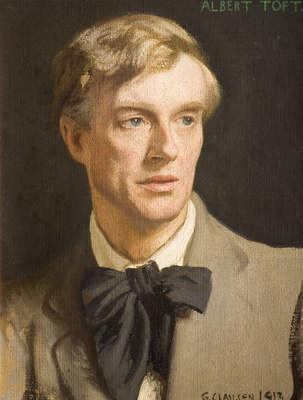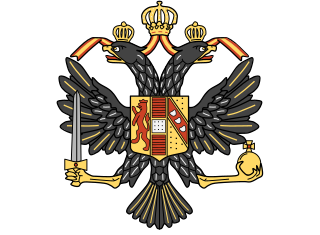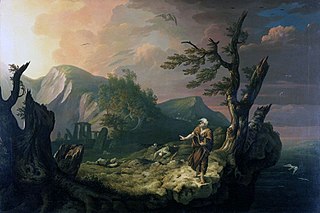Related Research Articles

Albert Toft was a British sculptor.

The Anzac Memorial is a heritage-listed war memorial, museum and monument located in Hyde Park South near Liverpool Street in the CBD of Sydney, Australia. The Art Deco monument was designed by C. Bruce Dellit, with the exterior adorned with monumental figural reliefs and sculptures by Rayner Hoff, and built from 1932 to 1934 by Kell & Rigby. This state-owned property was added to the New South Wales State Heritage Register on 23 April 2010.

The Royal Welsh is an armoured infantry regiment of the British Army. It was established in 2006 from the Royal Welch Fusiliers and the Royal Regiment of Wales.

1st The Queen's Dragoon Guards (QDG) is a regiment in the Royal Armoured Corps of the British Army. Nicknamed The Welsh Cavalry, the regiment recruits from Wales and the bordering English counties of Cheshire, Herefordshire, and Shropshire, and is the senior cavalry regiment, and therefore senior regiment of the line of the British Army.

The Royal Artillery Memorial is a First World War memorial located on Hyde Park Corner in London, England. Designed by Charles Sargeant Jagger, with architectural work by Lionel Pearson, and unveiled in 1925, the memorial commemorates the 49,076 soldiers from the Royal Artillery killed in the First World War. The static nature of the conflict, particularly on the Western Front, meant that artillery played a major role in the war, though physical reminders of the fighting were often avoided in the years after the war. The Royal Artillery War Commemoration Fund (RAWCF) was formed in 1918 to preside over the regiment's commemorations, aware of some dissatisfaction with memorials to previous wars. The RAWCF approached several eminent architects but its insistence on a visual representation of artillery meant that none was able to produce a satisfactory design. Thus they approached Jagger, himself an ex-soldier who had been wounded in the war. Jagger produced a design which was accepted in 1922, though he modified it several times before construction.

City Hall is a municipal building in Cardiff, Wales, UK. It serves as Cardiff's centre of local government. It was built as part of the Cathays Park civic centre development and opened in October 1906. Built of Portland stone, it is an important early example of the Edwardian Baroque style. It is a Grade I listed building.

The United Kingdom was one of the first countries to take part in Operation Enduring Freedom against the Taliban regime in autumn 2001.

Sir William Goscombe John was a prolific Welsh sculptor known for his many public memorials. As a sculptor, John developed a distinctive style of his own while respecting classical traditions and forms of sculpture. He gained national attention with statues of eminent Victorians in London and Cardiff and subsequently, after both the Second Boer War and World War I, created a large number of war memorials. These included the two large group works, The Response 1914 in Newcastle upon Tyne and the Port Sunlight War Memorial which are considered the finest sculptural ensembles on any British monument.

The Sydney Cenotaph is a heritage-listed monument located in Martin Place, in Sydney, New South Wales, Australia. It was designed by Bertram Mackennal and built from 1927 to 1929 by Dorman Long & Co. It is also known as Martin Place Memorial and The Cenotaph. It is one of the oldest World War I monuments in central Sydney. It was added to the New South Wales State Heritage Register on 11 November 2009.

The Animal Wall is a sculptured wall depicting 15 animals in the Castle Quarter of the city centre of Cardiff, Wales. It stands to the west of the entrance to Cardiff Castle, having been moved from its original position in front of the castle in the early 1930s. The design for the wall was conceived by William Burges, architect to the third Marquess of Bute, during Burges's reconstruction of the castle in the 1860s, but it was not executed until the late 1880s/early 1890s. This work, which included the original nine animal sculptures, all undertaken by Burges's favourite sculptor, Thomas Nicholls, was carried out under the direction of William Frame, who had previously assisted Burges at both Cardiff Castle and Castell Coch. When the wall was moved in the early 20th century, the fourth Marquess commissioned Alexander Carrick to carve a further six sculptures to sit on the extended wall which now fronted Bute Park. The Animal Wall is a Grade I listed structure.

Robert Thomas was a Welsh sculptor born in Cwmparc in the Rhondda Valley. He is best known for his work in bronze sculptures, many of which are on public display. He was one of the members of the 'Rhondda Group'.
This article is about the particular significance of the year 2009 to Wales and its people.

Welsh art is the traditions in the visual arts associated with Wales and its people. Most art found in, or connected with, Wales is essentially a regional variant of the forms and styles of the rest of the British Isles, a very different situation from that of Welsh literature. The term Art in Wales is often used in the absence of a clear sense of what "Welsh art" is, and to include the very large body of work, especially in landscape art, produced by non-Welsh artists in Wales since the later 18th century.

The Pozières Memorial is a World War I memorial, located near the commune of Pozières, in the Somme department of France, and unveiled in August 1930. It lists the names of 14,657 British and South African soldiers of the Fifth and Fourth Armies with no known grave who were killed between 21 March 1918 and 7 August 1918, during the German advance known as the Spring Offensive, and the period of Allied consolidation and recovery that followed. The final date is determined by the start of the period known as the Advance to Victory on 8 August.

Sarah Jane Rees, also known by the bardic name "Cranogwen", was a Welsh teacher, poet, editor, master mariner and temperance campaigner. She had two romantic friendships with women, first with 'Phania' Fanny Rees, until her death from tuberculosis, then with Jane Thomas, for most of the rest of Rees's life.

The statue of the Earl Kitchener is an outdoor bronze statue by John Tweed depicting Herbert Kitchener, 1st Earl Kitchener, installed in 1926 and located on the south side of Horse Guards Parade in London, United Kingdom. The sculpture stands on a Portland stone plinth. It became a Grade II listed building in 1970.
The 2007 New Zealand gallantry awards were announced via a Special Honours List on 2 July 2007, and recognised four New Zealand military personnel for actions while serving in Afghanistan in 2004. The identities of three of the four award recipients were not released for operational security reasons. Willie Apiata was awarded the Victoria Cross for New Zealand, the first and so far only time the decoration has been awarded since its inception in 1999.

A statue of Aneurin Bevan stands at the western end of Queen Street, Cardiff, Wales in recognition of Aneurin Bevan who is credited with founding the National Health Service (NHS). It has been described as "perhaps one of Wales' most iconic statues".
References
- ↑ "Big Picture: The Abandoned Soldier | the Psychologist".
- ↑ Power To The People: The Battle of Trafalgar Square BBC News
- ↑ Cardiff Castle Welcomes The Abandoned Soldier Archived 2012-12-24 at archive.today WelshIcons.org.uk
- ↑ Forgotten soldier statue erected by Cardiff Castle Archived 2012-01-31 at the Wayback Machine The Cardiffian
- ↑ "So can you help me decide which way to vote?". December 2014.
- ↑ "TAS Art - Experience Tour 2013 Part 7 : Snowdon Mountain Railway". YouTube .
- ↑ Garden of remembrance at heritage park to fallen troops BBC News
- ↑ The Abandoned Soldier The Cavalry and Guards Club, 127 Newsletter, March 2009
- ↑ Sculpture tribute to soldiers’ hardship Wales Online
- ↑ "Injured but not defeated". June 2006.
- ↑ Rhondda Heritage Park’s Garden of Remembrance 2011 Rhondda Heritage Business Club
- ↑ Memorial sculpture at risk of crumbling away Independent
- ↑ "Will You Remember Me : The Abandoned Soldier (TAS)". YouTube .